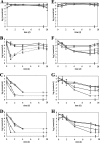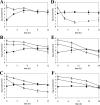Influence of native microbiota on survival of Ralstonia solanacearum phylotype II in river water microcosms
- PMID: 17873071
- PMCID: PMC2168212
- DOI: 10.1128/AEM.00960-07
Influence of native microbiota on survival of Ralstonia solanacearum phylotype II in river water microcosms
Abstract
Ralstonia solanacearum phylotype II biovar 2 causes bacterial wilt in solanaceous hosts, producing severe economic losses worldwide. Waterways can be major dissemination routes of this pathogen, which is able to survive for long periods in sterilized water. However, little is known about its survival in natural water when other microorganisms, such as bacteriophages, other bacteria, and protozoa, are present. This study looks into the fate of a Spanish strain of R. solanacearum inoculated in water microcosms from a Spanish river, containing different microbiota fractions, at 24 degrees C and 14 degrees C, for a month. At both temperatures, R. solanacearum densities remained constant at the initial levels in control microcosms of sterile river water while, by contrast, declines in the populations of the introduced strain were observed in the nonsterile microcosms. These decreases were less marked at 14 degrees C. Lytic bacteriophages present in this river water were involved in the declines of the pathogen populations, but indigenous protozoa and bacteria also contributed to the reduced persistence in water. R. solanacearum variants displaying resistance to phage infection were observed, but only in microcosms without protozoa and native bacteria. In water microcosms, the temperature of 14 degrees C was more favorable for the survival of this pathogen than 24 degrees C, since biotic interactions were slower at the lower temperature. Similar trends were observed in microcosms inoculated with a Dutch strain. This is the first study demonstrating the influence of different fractions of water microorganisms on the survival of R. solanacearum phylotype II released into river water microcosms.
Figures



References
-
- Anonymous. 1998. Council Directive 98/57/EC of 20 July 1998 on the control of Ralstonia solanacearum (Smith) Yabuuchi et al. Off. J. Eur. Communities L235:1-39.
-
- Anonymous. 2000. Council Directive 2000/29/EC of 8 May 2000 on protective measures against the introduction into the Community of organisms harmful to plants or plant products and against their spread within the Community. Off. J. Eur. Communities L169:1-112.
-
- Anonymous. 2006. Commission Directive 2006/63/EC of 14 July 2006: amending Annexes II to VII to Council Directive 98/57/EC on the control of Ralstonia solanacearum (Smith) Yabuuchi et al. Off. J. Eur. Communities L206:36-106.
-
- Arana, I., A. Irizar, C. Seco, A. Muela, A. Fernández-Astorga, and I. Barcina. 2003. gfp-tagged cells as a useful tool to study the survival of Escherichia coli in the presence of the river microbial community. Microb. Ecol. 45:29-38. - PubMed
Publication types
MeSH terms
LinkOut - more resources
Full Text Sources

